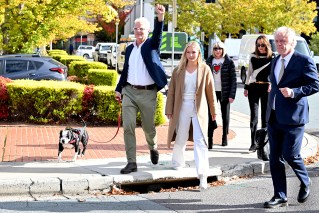Sights on empty office blocks as a housing solution


Less than 20 per cent of employers are requiring their workers at the office five days a week. Photo: Getty Photo: Getty
Office work was changed forever when the COVID-19 pandemic began, and while life has mostly returned to what it was before 2020, offices are still empty – so is it time we repurposed them as housing?
The housing crisis that continues to grip Australia means there’s a widespread lack of affordable homes available to buy and rent in large parts of the country.
That’s why Associate Professor Philip Oldfield, from UNSW’s School of Built Environment, thinks turning empty offices into housing is an idea that should be pursued.
“We’ve got a series of office buildings that are not as occupied as we’d like, and we need apartments,” he told The New Daily.
“So you can put two and two together and think ‘well, look, this makes sense’ and to a certain degree, it does.”
There are two benefits to converting office buildings into housing – the most obvious being we have more housing, Professor Oldfield said.
The second reason is that it would cut down on emissions because you’d prevent new building materials being used to make new dwellings.
However, not all office buildings are fit for living. If you convert an office to a home with no windows or balconies, in a peri-urban office area with no amenities around, then it just wouldn’t make sense.
This idea of repurposing office spaces into housing shouldn’t be a “one size fits all” solution, Professor Oldfield said.
Instead, it’s about being strategic and acknowledging in some cases it would work and in others, it’s best to not even think about it.
“Every house we create now will be standing in 100 years,” he said.
“So we’ve got to be very careful that what we create is of high quality and we’d be happy for our grandchildren to live there.”
Could this bring about 15-minute cities?
The concept of a 15-minute city has caused some controversy in fringe groups recently.
The idea is about having everything one would need – supermarkets, eateries, essential services – within a 15-minute walk from one’s home.
In theory, if office buildings were converted into housing, many office buildings are well connected to essential services and amenities.
“So much of many people’s lives are stuck in a traffic jam … being entirely reliant on the car is not a liberating thing,” said Professor Oldfield, who admits the concept is incredibly “aspirational”.

Australia needs to rethink the housing we are building. Photo: Getty
Increasing housing density
When news broke recently of Melbourne becoming a “bigger” city than Sydney over a technicality, ANU demographer Dr Liz Allen said the question we need to be asking is: What should our cities look like in the future?
Major cities are sprawling out, though there is potential to build up in areas where people would have access to amenities and be close to work.
In Victoria, the state government wants to add an additional one million homes into Melbourne’s suburbs by 2050, ideally in areas that are already built up instead of newer suburbs closer to the urban fringe.
According to The Age, the Victorian government would like to streamline this process by removing local councils from planning decisions in order to add more homes in built-up areas.
Local councils, and local resident action groups in inner city and more established areas, have often moved to block such developments.
In an ideal world, we would be building – or repurposing – housing in exisiting areas that are close to essential services and amenities, Professor Oldfield said.
“That is key to a quality of life. That’s quite key to a sustainable life,” he said.
The housing crisis was a “wicked problem” and no one solution would fix it.
“We’ve kind of gone to the polarising sides,” he said.
“We either build tower blocks around train stations, or we build detached houses on the fringe of the city. We’ve got this missing middle – the three- to five-storey apartment buildings that might be walk up, that are relatively straightforward to build, that we can slot into places.”
Although there is sometimes reluctance from residents and councils to build three- to five-storey buildings, they could help alleviate future housing problems.
Changing the system
There is no ‘silver bullet’ to fix the housing crisis, but there are things that can be done that, in turn, may make way for a more sustainable future where access is easier.
Beyond simply building more homes, government-funded social housing is needed, Professor Oldfield said.
“We need to de-commodify housing, so change it from a system of purely financial gain.
“So we need a government-funded, large-scale housing retrofit policy, where we insulate and improve all our existing housing stock.
“Building, alone, won’t solve the problem.”








